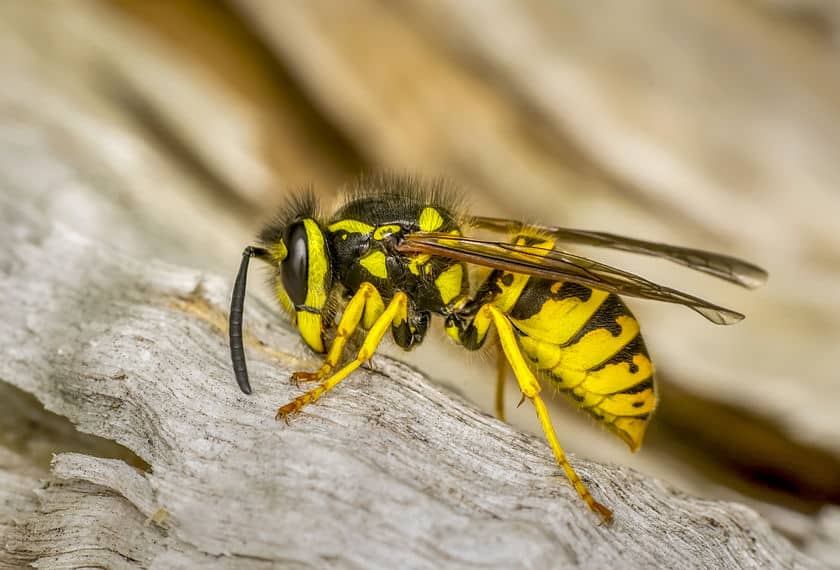If you’ve ever noticed thin scratches or small holes seemingly forming across the surface of an outdoor structure – such as furniture, siding, or decking – you may have a wasp infestation on your hands. Wasps can chew through building materials that include some forms of plastic and wood, compromising the integrity of your home.
Wasps can chew through plastic and wood. They have the instinct to feed on hard materials that they use to build durable nests. They prefer chewing on organic materials like wood but can resort to chewing through thin plastic to fulfill their appetite and build a nest.
Although wasps can chew through wood with ease, they aren’t as eager to do the same to plastic, especially thicker grades of plastic. To get a better understanding of why wasps are feeding off of your outdoor surfaces and how you can deter them, read on, and learn about their natural food selection process and what prevents them from wreaking havoc on your home.
Do All Wasps Chew Through Plastic and Wood?
As with most insects, there are various wasp subspecies, and not all are eager to feast away on houses. Some of the most common species, including Paper Wasps and Yellow Jackets, are frequent culprits of girdling, or chewing, on your outdoor surfaces. These two types of wasps use the pulp from wood to create sturdier nests.

Why Is Wood So Enticing?
Wood is high in natural cellulose, a fiber that enhances its strength and density, and wasps use these compact fibers to build their intricate nests. When the wood starts to deteriorate, its raw cellulose tissues are exposed and begin to attract more hungry wasps.
Plastic as a Last Resort
Unlike their desire for wood, wasps don’t actively seek out plastic even though they can potentially chew through thinner grades of it, such as plastic bags if they’re in dire need of food to build their nest.
Thicker plastic forms, including plastic furniture or plastic bottles, are less likely to become food for wasps.
What This Means for Your Home
Since wasps can chew through some forms of plastic and most types of wood, it doesn’t mean you need to surrender your home entirely to these pesky critters, as using good deterrents and preventative measures will encourage the wasps to seek out food elsewhere.
The longer wasps feed off of your home’s framework or outdoor areas; the more fragile and hazardous your property will become. However, if your home’s outdoor surfaces remain inhospitable, wasps will naturally migrate and take up residence where there is an active food source.
How To Divert Wasps
There are a few ways to get rid of wasps once and for all that include DIY solutions and pesticides used by professionals. By regularly treating your wood and your home’s exteriors, you can easily redirect any wasps that want to dine for free on your patio furniture, siding, or decking.
Find the Nest
If you notice many wasps lingering around a specific outdoor area, it is likely a sign that a nest is nearby. Wasps build their nests in shaded but secure areas, including chimneys, attics, around fascia boards, or in between tree limbs.
Wasps will not travel far in between feedings, so locating the nest will help you determine the extent of the infestation, what sections of your home to treat, and whether or not you need a pro to remove the nest.
Do not attempt to remove the nest on your own, as doing so could agitate the wasps and lead to injuries.
Take Action
To discourage wasps from continuing to munch on your surfaces, consider using some essential oils. Studies have shown that using powerful essential oils, like lemongrass, peppermint, and citronella has proven successful in keeping wasps away from your property.
When using these essential oils to stop wasps, mix small oils ratios with water in a spray bottle and apply them to your outdoor surfaces for optimal results.
Another popular wasp control method is to use a wasp trap. As mentioned previously, wasps are less likely to eat through thicker grades of plastic, similar to the kind used to create plastic soda bottles, which makes them perfect for a homemade wasp trap.
Enlist the Pros
If you still aren’t seeing success in combating your wasp problem, it’s probably time to call in the experts. Pest control professionals use industrial-grade pesticides that are designed to ward off wasps of all kinds and protect your outdoor surfaces.
Pest control experts can also help remove a growing wasps nest and prevent them from congregating around the exteriors of your home or continuing to feed off your outdoor furniture, siding, or decking.
Conclusion
Since wasps can easily chew through various materials, such as flimsy plastics and thick wood, it’s important to recognize when wasps are attacking your outdoor areas so you know how to restrict the damage caused. With some items you likely already have around the house and support from your local pest control company, you can quickly and efficiently put an end to your wasp problem while maintaining the durability of your home’s infrastructure.
